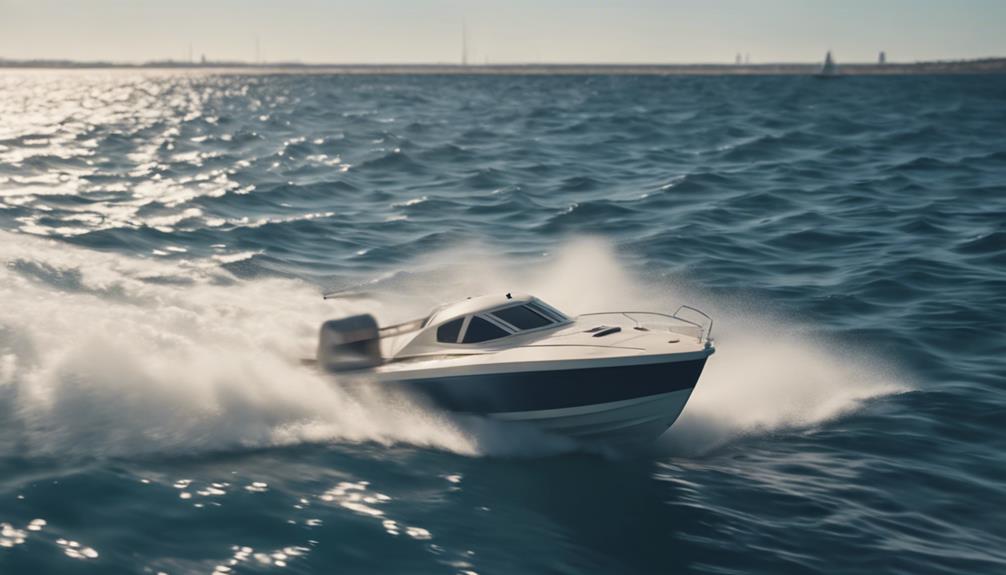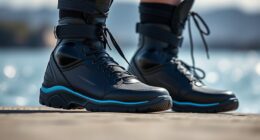To guarantee comfort and safety while sailing, choose breathable, waterproof clothing with adjustable features to keep dry and allow airflow. Wear a properly fitted life jacket or PFD with safety certification for buoyancy and visibility. Opt for non-slip sailing shoes and impact-resistant headgear to prevent injuries. Use sun protection accessories like hats, sunglasses, and sunscreen, and pack essential navigation and signaling devices. Proper gear organization and emergency equipment further boost confidence, helping you stay prepared in any situation.
Key Takeaways
- Choose breathable, waterproof clothing with adjustable features to stay dry and comfortable in varying weather conditions.
- Select properly fitted life jackets or PFDs with appropriate buoyancy and safety certifications for reliable flotation.
- Wear non-slip sailing shoes and impact-resistant headgear to prevent injuries and maintain safety on deck.
- Use reliable navigational and signaling devices, like GPS, charts, flares, and whistles, for effective communication and emergency response.
- Incorporate sun protection accessories and moisture-wicking gear to enhance comfort and shield against harsh environmental elements.
Choosing the Right Waterproof Clothing
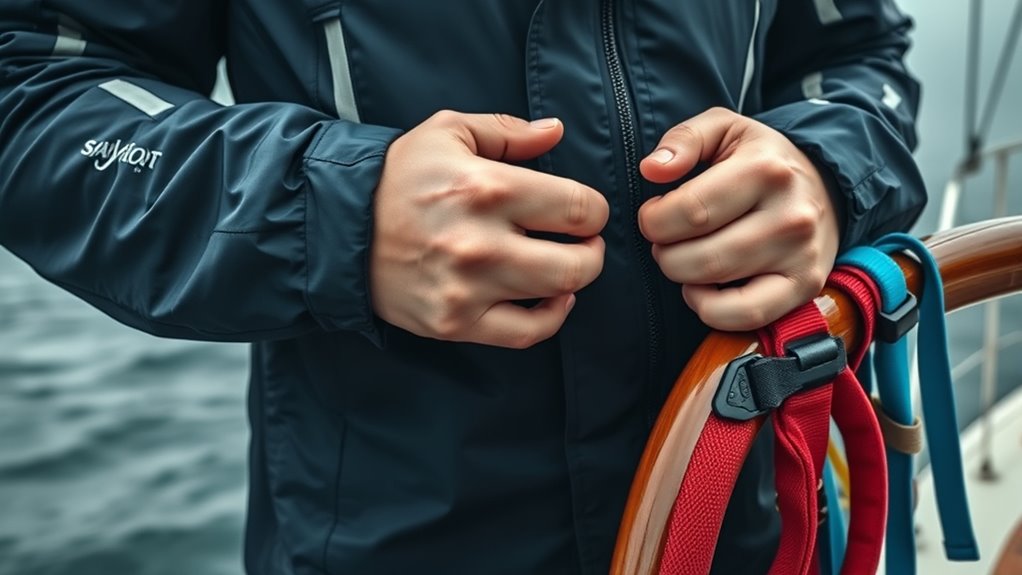
When selecting waterproof clothing for sailing, it’s essential to prioritize function and fit. You want gear that keeps you dry and comfortable without restricting movement. Look for jackets and pants made from breathable, waterproof materials like Gore-Tex or similar fabrics, which prevent moisture from seeping in while allowing sweat to escape. Make certain the clothing fits well—loose enough for layering but snug enough to prevent water from entering at seams or gaps. Consider adjustable features such as cuffs, hoods, and waistbands for a secure fit in various conditions. Avoid overly bulky gear that hampers your mobility or causes fatigue. Properly fitted waterproof clothing enhances your sailing experience by keeping you dry, comfortable, and prepared to face changing weather conditions. Additionally, choosing gear with self-watering features can help maintain optimal comfort during extended sailing trips. Ensuring your clothing has a layering system allows you to adapt to temperature fluctuations effectively, and selecting the right ventilation options can further improve moisture management. Incorporating ventilation features such as underarm zippers or mesh panels can help regulate body temperature and reduce internal condensation. Being aware of breathable, waterproof materials ensures you select gear that balances moisture control and protection effectively.
Essential Life Jackets and Personal Flotation Devices
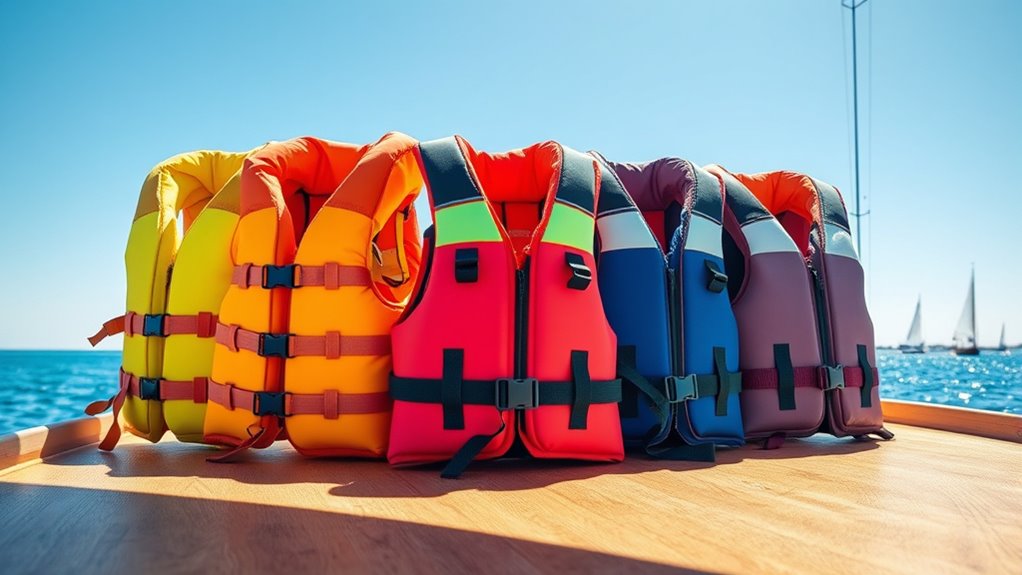
Choosing the right life jacket is vital for your safety on the water. You need to take into account different types, make sure it fits properly, and meets safety standards. Let’s explore how to select the best personal flotation device for your sailing adventures. Proper wearing and fitting of your life jacket is crucial to ensure it functions correctly in an emergency. Additionally, understanding wall organization systems can inspire you with ideas for creating safe and organized storage spaces on your boat, reducing clutter and improving accessibility. Incorporating knowledge about best anime movies can inspire you with stories of heroism and perseverance that resonate with safety and survival themes. Incorporating knowledge about Culinary Uses of Chia Seeds highlights how small but powerful items can enhance your health, just as proper safety gear can improve your sailing experience. Knowing how to select appropriate life jackets ensures both comfort and safety during your outings.
Types of Life Jackets
There are two main types of life jackets designed to keep you afloat in emergencies: essential life jackets and personal flotation devices (PFDs). Essential life jackets are usually bulkier, offering higher buoyancy and often containing built-in harnesses or reflective strips for added safety. They’re ideal for offshore or serious sailing, where extra security matters. PFDs, on the other hand, are generally lighter, more flexible, and designed for comfort during regular activities. They come in various styles, including foam-filled and inflatable options. Foam PFDs are reliable and easy to use, while inflatable models can be compact and less bulky. Both types are vital for safety, but choosing the right one depends on your sailing environment, activity level, and personal preferences. Additionally, selecting a candle sinking issue that matches your needs can improve your overall safety and comfort during extended outings.
Proper Fit and Size
A proper fit and size are essential for your life jacket or PFD to perform effectively in an emergency. If it’s too loose, it may slip off or fail to keep your head above water. Conversely, if it’s too tight, it can restrict your movement and cause discomfort. To find the right size, measure your chest at the widest point and compare it to the manufacturer’s sizing chart. Try on the PFD and fasten all straps securely; it should feel snug but not restrictive. Ensure you can breathe comfortably and that the jacket doesn’t ride up when you lift your arms. Remember, a well-fitting life jacket stays in place when you need it most, providing reliable buoyancy and safety. Additionally, choosing a Flat Iron Bike with appropriate features can enhance your overall sailing experience by ensuring proper gear compatibility. Proper gear selection is also crucial in promoting safety standards and preventing accidents. Recognizing the importance of mental wellbeing can further improve your preparedness and confidence on the water. Being aware of family photoshoot fails can remind you to stay relaxed and adaptable during outdoor activities. To optimize your safety, stay informed about local regulations and recommended safety practices to ensure compliance and peace of mind.
Safety Certification Standards
Have you ever wondered how to guarantee your life jacket will perform reliably in an emergency? Safety certification standards are your answer. These standards ensure that life jackets meet strict quality and performance criteria, giving you peace of mind on the water. When choosing a personal flotation device, look for labels from reputable organizations like the US Coast Guard, CE, or ISO. They verify that the jacket provides buoyancy, durability, and proper fit.
Key points to check include:
- Certification labels indicating compliance with safety standards
- Appropriate buoyancy rating for your weight and activity
- Proper fit to prevent slipping off during use
Always choose certified gear—your safety depends on it.
Comfortable and Durable Sailing Shoes
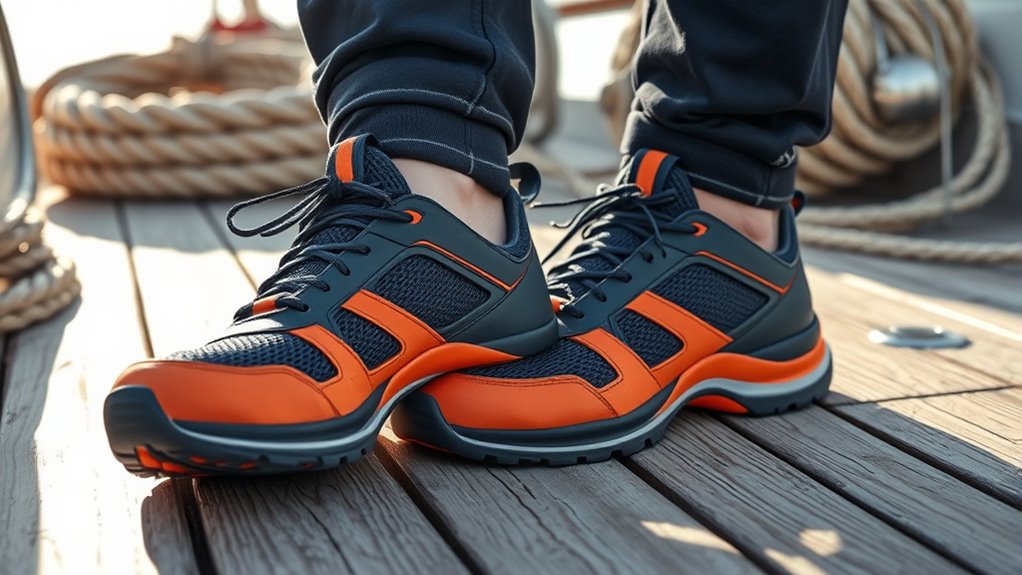
Finding the right sailing shoes is essential for comfort and safety on the water, as they need to provide both support and durability. Look for shoes with non-slip soles to prevent accidents and sturdy materials to withstand harsh conditions. Comfort is key; choose shoes with cushioned insoles and breathable uppers to keep your feet dry and comfortable all day. Durability ensures your shoes last through frequent use and exposure to water. Additionally, selecting shoes with features aligned with HVAC Systems technology, like efficient moisture management, can enhance overall comfort during long hours on the water. Incorporating automated design features can further improve fit and support, ensuring maximum safety and comfort during your sailing adventures. Proper ventilation in your sailing shoes can also improve moisture control, keeping your feet dry and reducing the risk of blisters.
Protective Headgear and Hats
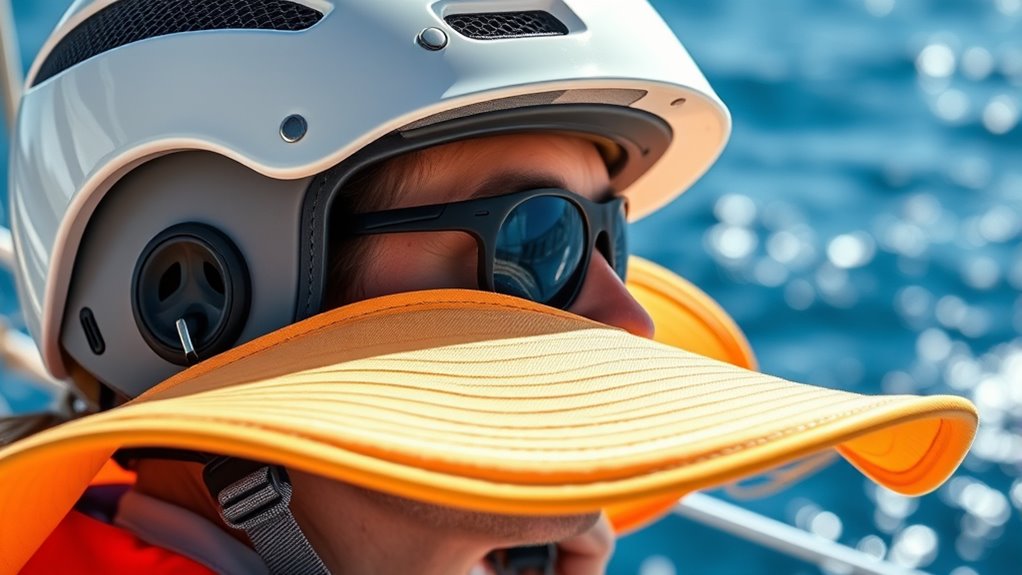
When choosing headgear for sailing, you want to prioritize sun protection and impact resistance. A good hat or helmet can shield your face from UV rays while absorbing shocks from sudden motions. Selecting the right gear helps keep you safe and comfortable on the water. Incorporating organic techniques such as using natural materials for the hat’s fabric can also enhance sustainability and comfort. Additionally, selecting diverse designs can match your style and improve your overall sailing experience. Ensuring the headgear is impact resistant adds an extra layer of safety during turbulent conditions. Considering the hours of operation of local stores can help you plan your shopping trips for the best selection.
Sun Protection Strategies
Protective headgear and hats are essential tools for shielding your face, neck, and scalp from the sun’s harmful rays while sailing. Wearing a wide-brimmed hat or a cap with a neck flap helps block direct sunlight and reduces the risk of sunburn. Look for hats made from breathable, quick-drying fabrics for comfort during long hours on the water. Additionally, consider hats with UPF (Ultraviolet Protection Factor) ratings to enhance sun protection. Pair your hat with sunglasses and sunscreen for all-encompassing defense. Staying protected not only prevents sunburn but also reduces the risk of heat exhaustion and long-term skin damage. Make sun protection a priority to enjoy your sailing adventures safely and comfortably.
Impact Resistance Features
Have you considered how impact-resistant features can enhance your safety on the water? Protective headgear, like helmets or impact-resistant hats, can prevent serious injuries from falls, collisions, or flying debris. Look for helmets with a durable outer shell and a shock-absorbing foam liner to absorb impacts effectively. Some hats incorporate reinforced brims or padded areas to protect critical spots without sacrificing comfort. Wearing impact-resistant gear ensures you’re better prepared for unexpected accidents, especially during rough weather or near busy docks. Properly designed headgear also helps minimize head injuries if you accidentally bump into rigging or equipment. By choosing gear with impact-resistant features, you boost your safety, confidence, and overall sailing experience. Always prioritize safety equipment that offers reliable impact protection on every voyage.
Optimum Sailing Gloves for Grip and Comfort

Choosing the right sailing gloves can make a significant difference in your grip and comfort on the water. You want gloves that provide a secure hold without sacrificing dexterity or causing discomfort. Look for gloves with textured palms and fingers to enhance grip, especially when handling ropes or winches. Breathable materials prevent sweating and chafing during long days on the water. Flexibility is key, so choose gloves with stretch panels that move with your hands. Durability matters too, so opt for reinforced seams and high-quality fabrics.
- Textured palms and fingertips for maximum grip
- Breathable, moisture-wicking materials for comfort
- Flexible designs with stretch panels for dexterity
Navigational Tools and Safety Equipment
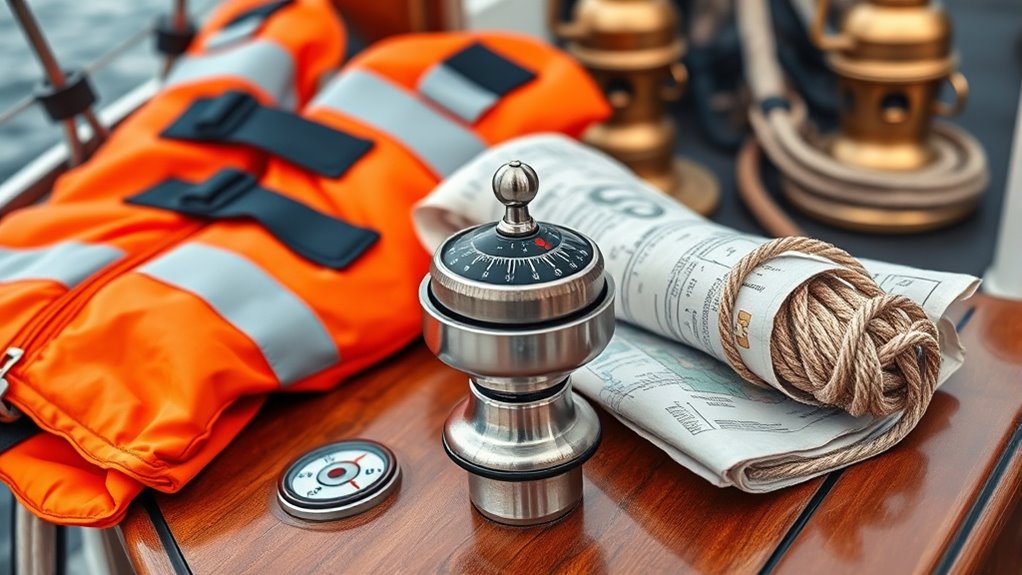
Navigational tools and safety equipment are essential for ensuring a safe and efficient voyage. You need reliable devices like a compass, GPS, and nautical charts to stay on course and avoid hazards. A depth sounder helps you monitor underwater obstacles, while a radio ensures you can communicate with other vessels or rescue services if needed. Safety gear such as life jackets, harnesses, and flares is crucial in emergencies, providing protection and signaling when necessary. Always check that your equipment is functional before setting sail. Keep backup batteries, spare parts, and a first aid kit onboard. Properly maintaining and understanding your navigational tools and safety gear helps you respond swiftly to unexpected situations, ensuring both your safety and that of your crew.
Weather-Resistant Outerwear
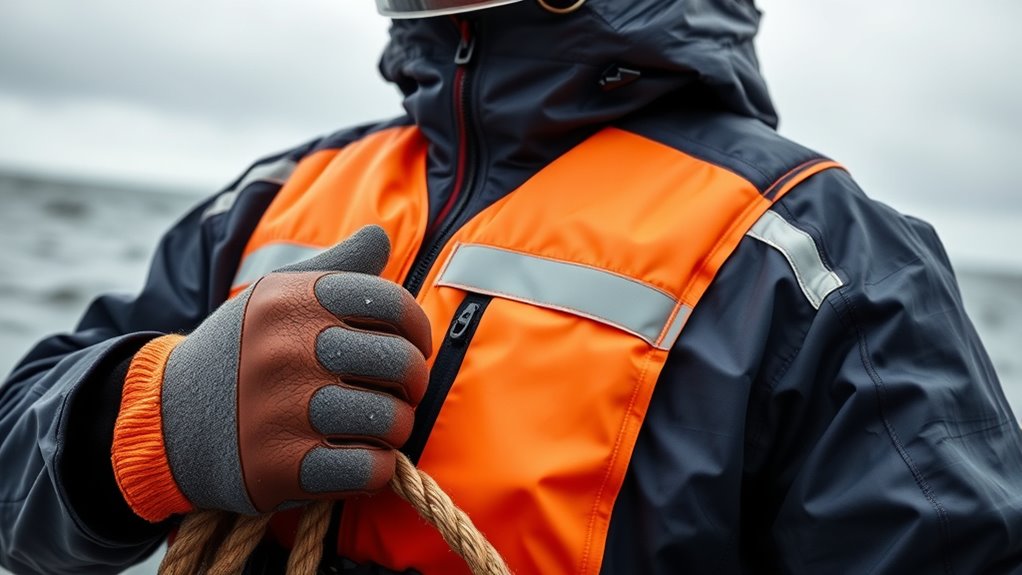
When choosing weather-resistant outerwear, you’ll want gear made from waterproof materials that keep you dry in heavy rain. Breathable fabrics are equally important, allowing sweat to escape and preventing you from feeling clammy. Together, these features guarantee you stay comfortable and protected on the water.
Waterproof Materials
Waterproof materials are essential for weather-resistant outerwear, ensuring you stay dry and comfortable in wet conditions. They form a reliable barrier against rain, splashes, and spray, keeping you focused on sailing rather than discomfort. When choosing waterproof gear, pay attention to the fabric’s waterproof rating and seam sealing for maximum protection. Look for materials that resist water penetration while remaining durable enough to withstand harsh conditions. Keep in mind that quality waterproof fabrics also dry quickly and resist mold or mildew. To get the best performance, combine waterproof materials with breathable linings for comfort.
- Gore-Tex and similar membranes for high waterproof ratings
- PU (polyurethane) coatings for affordability and water resistance
- Seam-sealed construction to prevent leaks
Breathable Fabrics
While waterproof fabrics keep you dry, they can sometimes trap heat and moisture inside, leading to discomfort during physical activity. That’s where breathable fabrics come in. They let sweat and moisture escape, keeping you comfortable even during intense sailing. Look for materials like Gore-Tex or eVent, which offer both waterproofing and breathability. Choosing the right fabric can prevent chafing and overheating, so you stay focused on your sail.
| Feature | Benefit |
|---|---|
| Moisture-Wicking | Keeps sweat away from your skin |
| Ventilation Zones | Promotes airflow, cooling you down |
| Lightweight Fabric | Reduces fatigue during activity |
| Quick-Drying | Ensures you stay dry and comfortable |
Sun Protection Accessories
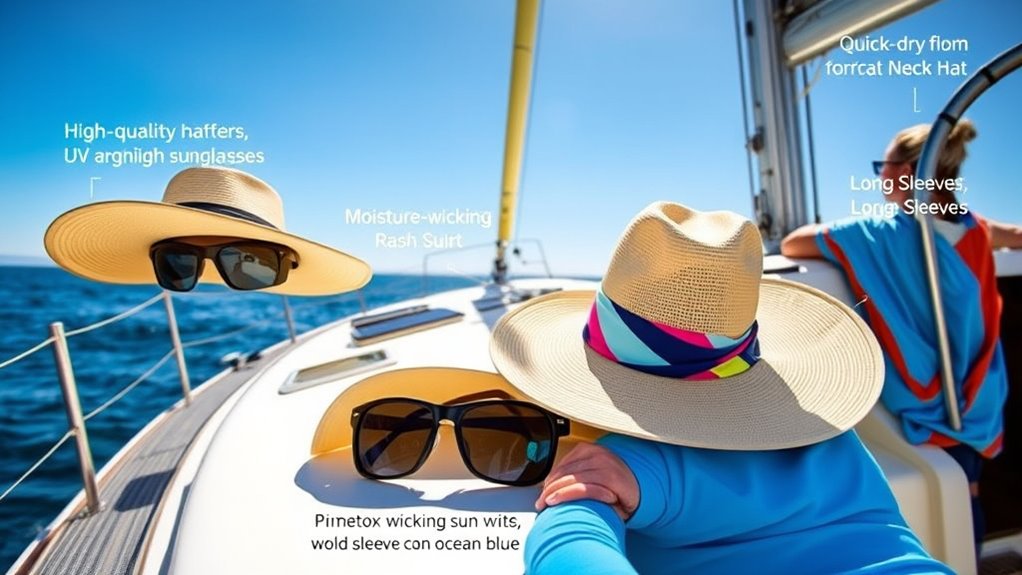
To protect yourself from the sun’s harmful rays while sailing, investing in the right sun protection accessories is crucial. These items help reduce exposure and keep you comfortable on the water. A wide-brimmed hat offers excellent shade for your face and neck, preventing sunburns. Sunglasses with UV protection shield your eyes from glare and UV damage, improving visibility and comfort. Additionally, a good quality sunblock is essential—apply it generously and frequently, especially on exposed skin. These accessories work together to minimize sun risk and enhance your sailing experience. Be sure to choose items that are lightweight, breathable, and quick-drying for maximum comfort during long hours under the sun. Staying protected ensures you enjoy your voyage safely and comfortably.
Practical Storage and Crew Gear
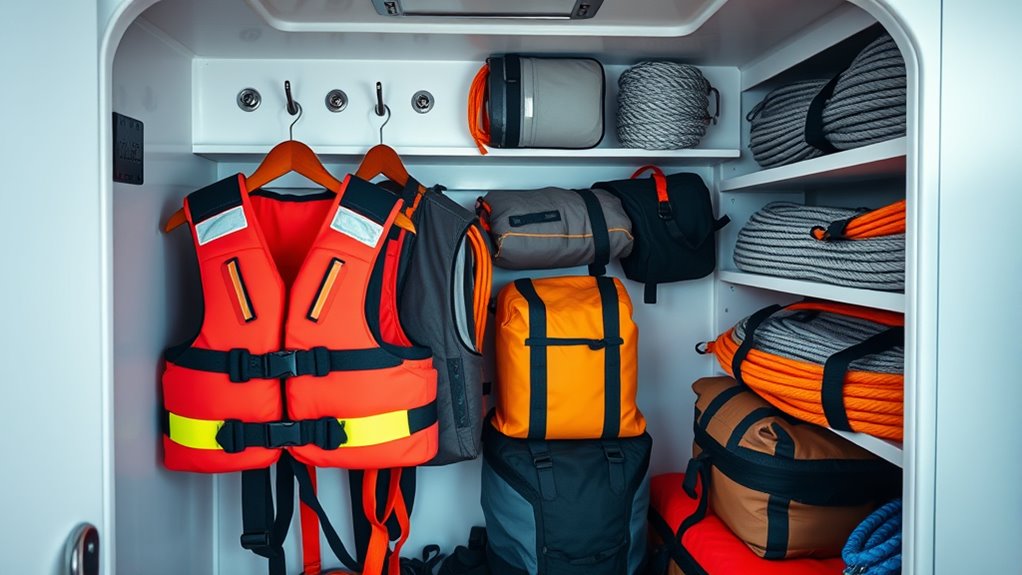
Effective storage solutions are essential for keeping your sailing gear organized and accessible during your trip. Use waterproof containers and dry bags to protect valuables and crew gear from moisture. Stow items like charts, tools, and spare clothing in easily reachable compartments. Consider installing dedicated lockers or shelves to prevent clutter and make packing efficient. Crew gear such as life jackets, gloves, and hats should be stored in designated spots for quick access. Compact, lightweight gear is preferable to avoid overcrowding. Label storage areas clearly so everyone knows where to find what they need. By maintaining a tidy, well-organized setup, you’ll streamline operations onboard and ensure safety and comfort throughout your sailing adventure.
Emergency Preparedness Equipment

Organizing your sailing gear includes ensuring you’re prepared for emergencies. Having the right emergency equipment can make all the difference if things go wrong. You should carry a well-stocked first aid kit, including bandages, antiseptic, and pain relievers. A reliable waterproof flashlight and extra batteries are essential for nighttime situations. Additionally, keep a set of signaling devices like flares, whistles, or mirrors to attract attention. Make sure all items are easily accessible and regularly checked for functionality. Properly stored emergency gear boosts your confidence and safety on the water, helping you respond swiftly to unexpected events. Remember, preparation is key to enjoying sailing safely and confidently, no matter what challenges you might face.
Frequently Asked Questions
How Do I Choose the Right Size for Sailing Gear?
When choosing the right size, you need to focus on proper fit to guarantee comfort and safety. Measure your chest, waist, hips, and inseam accurately, then compare these to the manufacturer’s sizing chart. Don’t just rely on general sizes—try on gear if possible, or read reviews for fit insights. Remember, snug but not tight gear keeps you comfortable and secure on the water.
What Safety Standards Should My Sailing Equipment Meet?
You might think safety standards are just formalities, but they’re essential for your protection on the water. Always check that your sailing equipment meets recognized certifications like ISO, CE, or USCG standards. These ensure your gear withstands harsh conditions and keeps you safe. Don’t compromise—trust gear that’s tested and certified. Proper safety standards aren’t just regulations; they’re your safeguard against accidents and emergencies at sea.
How Often Should I Replace My Sailing Gear?
You should replace your sailing gear regularly to guarantee safety and comfort. Check your equipment before each trip for signs of wear, damage, or deterioration. Replace items like life jackets, ropes, and harnesses every 3-5 years, or sooner if they show significant wear. Always follow manufacturer recommendations and inspect gear after heavy use or exposure to harsh conditions. Staying proactive keeps you safe on the water.
Are There Eco-Friendly Options for Sailing Clothing?
You’re wondering if eco-friendly sailing clothing exists. Yes, it does! You can choose gear made from sustainable materials like recycled polyester, organic cotton, or hemp. Look for brands committed to environmental responsibility, which often use eco-friendly dyes and ethical manufacturing practices. Not only will you stay comfortable and safe on the water, but you’ll also help protect the oceans and our planet for future generations.
How Can I Personalize My Sailing Gear for Better Visibility?
To personalize your sailing gear for better visibility, you can add bright, reflective patches or tapes to your clothing and gear. Use high-contrast colors like neon yellow or orange to stand out. Customizing with bold patterns or your name makes it easier for others to spot you on the water. You might also consider attaching LED lights for night sailing, ensuring you’re visible in all conditions.
Conclusion
With the right sailing gear, you’ll navigate every adventure with confidence and comfort. Imagine setting sail on a rainy day, confidently dressed in waterproof clothing and a reliable life jacket—staying dry, safe, and focused on the horizon. Proper gear isn’t just about comfort; it’s your safeguard against the unpredictable. Equip yourself wisely, and every voyage becomes an enjoyable and safe experience, no matter the weather.



